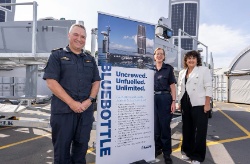Deerstalkers Deplore EPA Approval of MZP
15 August 2011
Media statement
For immediate release
Deerstalkers Deplore EPA Approval of MZP
The National Executive of The New Zealand Deerstalkers’ Association is concerned to see yet another approval of yet another very toxic agent for use against possums.
The Environmental Protection Agency’s (EPA) approval of importation for manufacture or release, of micro-encapsulated zinc phosphide, (MZP), sees us taking a giant step backwards. This decision will see Pest-tech Ltd importing a substance, which in paste form, may be more hazardous to handlers, dogs, and non-target species than ground-based applications of 1080 are now.
NZDA accepts that the application has been approved by EPA, strictly for ground use. However, it notes the range of novel controls attached to its use, which the National Executive believes will make it unattractive to pest control agencies, unsuitable for large ground-based operations and unpalatable to many users of the outdoors.
MZP produces a highly volatile gas called phosphine (Ph3), and this can be highly toxic to people and animals. Phosphine appears to be produced in the encapsulated and paste form on the slightest contact with acids, water or water vapour, and controls the EPA has introduced clearly anticipate high risks which may be posed by this gas, if not by the paste product itself.
We note the decision report shows that:
EPA staff were not supplied with adequate data in some studies, for the formulation of zinc phosphide which has been approved;
EPA staff were unable to draw adequate conclusions about its efficacy with bird repellents, because the applicant provided no data about its use with bird repellents;
EPA staff strongly recommended during their evaluation and review that use of MZP be allowed only where buffer zones were put in place around waterways. This makes the toxin, in NZDA’s view no better than 1080, and potentially worse, given its known toxicity to fish and other aquatic life;
The decision committee has inserted alterations to default controls for identification, signage and packaging, specifically to accommodate the highly volatile nature of MZP, and to mitigate risks to users and handlers who may come into contact with phosphine gas. NZDA sees this is a bizarre situation allowing people to risk exposure of themselves and non-target species to a very dangerous substance, where lower impact substances may be just as effective;
The decision includes controls allowing the Ministry of Health and the Department of Conservation to impose additional controls through permissions under S95A of the HSNO Act. NZDA sees this as a sign that this toxin is far from safe, and notes the same controls are mandatory for aerial or ground-based use of 1080;
The decision includes additional controls on labelling and transportation, which clearly show this substance poses risks if gases it produces are inhaled, in all but the most stringent conditions. NZDA believes manufacture of this substance may pose higher risks to handlers and bystanders especially where the odour it emits, is no guide to safe exposure limits.
NZDA believes this dangerous toxin will not help to promote greater use of ground-based pest-control operations. We believe alternative methods to poisons, rather than more and riskier poisons, are the answer to future pest control needs.
ENDS


 Gordon Campbell: On The Left’s Electability Crisis, And The Abundance Ecotopia
Gordon Campbell: On The Left’s Electability Crisis, And The Abundance Ecotopia NZCAST: NZCAST Leads Ongoing Cross-Agency Collaboration To Break Down Barriers For Survivors Of State Abuse
NZCAST: NZCAST Leads Ongoing Cross-Agency Collaboration To Break Down Barriers For Survivors Of State Abuse Regional and Unitary Councils Aotearoa: Regional And Unitary Councils Back A Practical FWFP System
Regional and Unitary Councils Aotearoa: Regional And Unitary Councils Back A Practical FWFP System NZ Government: Stay Safe On Our Roads This Easter
NZ Government: Stay Safe On Our Roads This Easter YWCA: Global Push Back Against Gender Equality A Growing Crisis In Aotearoa
YWCA: Global Push Back Against Gender Equality A Growing Crisis In Aotearoa Te Pāti Māori: Ngarewa-Packer - Fast-Tracking Seabed Mining Ignores Māori Opposition And Environmental Precedent
Te Pāti Māori: Ngarewa-Packer - Fast-Tracking Seabed Mining Ignores Māori Opposition And Environmental Precedent New Zealand Defence Force: Defence And Customs Strengthen Maritime Security With Uncrewed Surface Vessels
New Zealand Defence Force: Defence And Customs Strengthen Maritime Security With Uncrewed Surface Vessels


